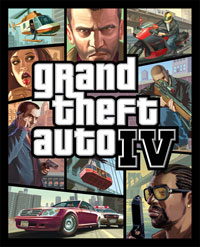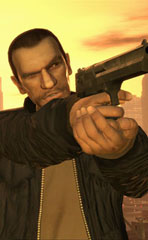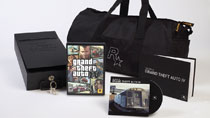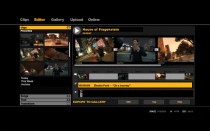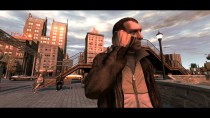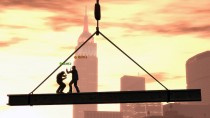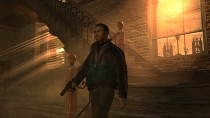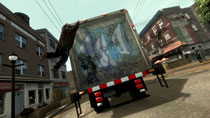Dragon NaturallySpeaking 12 Premium
Key Features: Over 99 per cent potential accuracy; Faster Performance engine; Dictate wirelessly using an iPad or iPhone; Post straight to Facebook & Twitter; Full Gmail & Outlook.com compatibility
Nuance Dragon NaturallySpeaking 12 - Features and Setup
Introduction
Nuance Dragon NaturallySpeaking 12 Features
Nuance Dragon NaturallySpeaking 12 Setup
Grand Theft Auto IV
About GTA IV...
The Unveiling of GTA IV
The PC Version
Main Features
GAMEPLAY
- Niko can use a mobile phone to recieve calls and phone his contacts in order to arrange missions. He can also use it to call taxis and purchase weapons. The options presented on the phone's LCD are Phonebook, Messages, Organizer, and Camera. The phone can also be used to access multiplayer.
- Pedestrians perform realistic actions. They smoke cigarettes, read books and newspapers, drop litter, talk on mobile phones, walk in and out of buildings, and generally act like any normal pedestrian in a real city would.
- GTA IV features fifteen multiplayer modes, which can be accessed through the mobile phone. Multiplayer supports up to sixteen players, and the game modes include Deathmatch, Mafiya Work, Cops n' Crooks and Free Mode.
- It is possible to surf the internet in GTA4 via internet cafés. It is available from any computer in the game, and provides a hub for all sorts of interactivity within Liberty City. There are over 100 in-game internet websites.
- In GTA IV, you will gain a police wanted level for any crime that you commit, providing there are witnesses present. The police can only chase you if they know where you are, and they need to see you to know where you are. If you escape the search area marked on the radar without being spotted, your wanted level will disappear.
- In terms of scale, GTA IV is about the same size as GTA: San Andreas, but the map size is considerably smaller. This is mainly due to the fact there is no desert or countryside in Liberty City. Liberty City in GTA4 is the biggest single city that R* have ever created.
- In GTA IV, the line between on- and off-mission has been blurred, and the story is less linear. It is also possible to do more than one mission at a time. For example, some missions take place over several days and may involve waiting for phonecalls or attending interviews, and you are free to carry out other business during the waiting period.
- The story can be told in a number of different ways. Rockstar are trying to give people greater freedom and sense of control over their destiny. You now have a lot more choice in what you want to do.
- Niko has the ability to climb and descend telephone poles, and exterior fire escapes.
- Every street in Liberty City contains a street sign with a name on it.
- Cars feature GPS navigation systems, which identify the best routes to take during missions, and highlight them on the radar.
- Developing relationships with characters is an important aspect of the gameplay. Maintaining good relationships will provide different rewards to Niko. Niko can socialise with other characters in order to maintain a good relationship, for example they can go bowling together, they can go to the cabaret, go to comedy clubs, and go drinking together.
TECHNOLOGY
- Grand Theft Auto 4 runs on Rockstar's proprietary next generation game engine, R.A.G.E., allowing for an unprecedented level of realism and interactivity.
- New sunlight and weather effects which give the city a whole different appearance as the time of day progresses.
- Volumetric lighting effects allow sunlight to stream realistically into dusty interiors. Police spotlights will likely benefit from this effect as well when helicopters kick up debris.
- Normal (bump) maps will provide much more detail in models than the underlying polygons, as well as giving materials more texture and depth.
- Road and building textures are more varied than in previous GTAs. On some roads you will find potholes, metal plates (etc) where the road has been dug up.
- Modern pixel shaders give water, glass, cars, etc.. more realistic reflections and shininess than the earlier games.
- In cars, you can see real reflections on the rear and side-view mirrors.
- There are no load times in GTA4, not even during exterior-interior transitions (and vice versa.)
- GTA4 uses euphoria, a fully procedural animation package created by NaturalMotion. The core technology is the Dynamic Motion Synthesis (DMS) system.
- Variations in the terrain are met with realistic changes in the walking animation.
- Unique game moments. Animations are created on the fly, so each player's experience will be unique. Gamers are no longer subjected to pre-recorded animations.
- Characters will react realisticaly to being hit with gunfire, cars, and melee weapons or fists.
- Players will be able to push people out of the way, rather than "floating" past them as in older games.
- Falling/thrown characters will react as in real life- They won't simply be limp, lifeless ragdolls. Nor will they use a canned "super hero" animation like before.
- Characters (and players?) will be able to hang on to helicopters and trucks, which will swing them around as the vehicle moves.
Minimum System
- Operating System: Windows Vista Service Pack 1 OR Windows XP Service Pack 3
- Processor: Intel Core 2 Duo 1.8Ghz or AMD Athlon X2 64 2.4GHz
- Memory/RAM: 1.5GB for Vista, 1GB for XP
- Hard Disk Space: 16GB Free
Recommended System
- Operating System: Windows Vista Service Pack 1 OR Windows XP Service Pack 3
- Processor: Intel Core 2 Quad 2.4GHz, AMD Phenom X3 2.1GHz
- Memory/RAM: 2.5GB for Vista, 2.5GB for XP
- Hard Disk Space: 18 GB Free
- Video Card: 512MB NVIDIA 8600 or 512MB ATI 3870
GTA San Andreas [NEW DOWNLOAD LINK!]
GTA San Andreas




Minimum System
| Recommended System
|
- Save your player stats to a HTML file, which can be put on the internet and shared with others.
- Photos taken with the in-game camera can be exported as .JPG screenshot files.
- Rockstar have claimed the "modding community will be supported." Specifically in what ways is yet to be seen.
It was decided that the PC version of San Andreas will not have an inbuilt 2-player mode as "the dual keyboard and mouse set up proved too unwieldy for players and didn't work with the PC version of San Andreas' greatly improved free camera mechanics. Rockstar North decided to focus on maximizing the single player experience."
Download Tutorial
True Crime® New York City

True Conflict. True Power. True New York.
- Street Justice Bust criminals, take down gangs, search, seize, extort, take bribes, confiscate, interrogate, use informants and dispense justice your way – by the book or by indulging in the temptations of the job.
- Run New York City Regulate the city from Times Square and Harlem to Little Italy, Chinatown and every neighborhood in between. Take taxis, subways, and enter virtually every building in the city from music stores to clothing stores, clubs and more.
- Living, Breathing City Your attitude towards crime affects the way it looks and feels. Let crime go unchecked or contribute to it yourself and watch the city fall apart around you. Clean up crime and see it prosper along with your career.
- Everything’s a Weapon Tables, stoves, ovens, chairs, machines and anything else you see can be used to fight your enemies. Additionally, wield police issued weapons like pistols, grenades and rifles, or use your cash to buy black market firepower like flamethrowers, semi-automatics, Molotov cocktails and more.
- Brawl Your Way Seamlessly choose one of five unique fighting styles to bust up perps depending on your enemy or preference.
- Navigate the ‘Hoods Use SUVs, motorcycles, sportscars, police vehicles, trucks, buses and more to cruise around or gun down enemies. Or take cabs or the subway for direct routes.
- Supported Video cards: NVIDIA: GeForce FX series, GeForce 6 series, GeForce 7 series ATI: X500 series, X550 series, X800 series, X850 series, Radeon 9500 series, Radeon 9550 series, Radeon 9600 series, Radeon 9700 series, Radeon 9800 series
Download Tutorial
Coming Soon!
Spider-Man 3

After more than 20 years of comic books and cartoons, I'd like to think I'd be a pretty good superhero if I was bombarded with cosmic rays or given a mysterious green ring. However, after spending some time with Spider-Man 3, I'm starting to doubt I could save New York without throwing up all over it.
Download Tutorial
Will be available soon!
Saints Row 2

The streets of Stilwater have changed. Now it's time for you to blow them all to hell.
The missions, and there are a lot of them, do a good job of staying varied throughout your onslaught to bring down each gang. There are missions where you'll be throwing fireworks out of the back of a truck or you'll have to evade a group of trucks in a makeshift demolition derby. While there are still the standard "go kill everyone here, then go kill everyone here" type of missions that get slightly monotonous over time, the majority stay varied and fun. The development team at Volition also added a handy checkpoint system which should eliminate some of the frustrations that were felt in the first game.
Aside from the aforementioned touch of adding a checkpoint system, there are also a few other finite additions that are worth mentioning. The first is that of cruise control. To ease the art of the drive by, players can now hold the left shoulder button to keep the speed of their car steady so their right thumb can then return to aiming. Second, when swimming you can now press a face button to instantly warp to the shore. Unsurprisingly this game is best played with a 360 gamepad. Playing with a keyboard and mouse might save you some general aiming accuracy, but the overall fun isn't quite the same.
So the gameplay is fun, wacky and varied. The production values may not be as high as they are elsewhere, but Saints Row 2 is more of a low-budget Bruckheimer flick than a Scorsese-style Departed, so that's really no big deal.
The real negatives for Saints Row 2 come in the technical department. And on PC these sadly cripple the game. From graphics to AI to the sheer inner-workings of the game, SR2 has blemishes in every area. First, graphically, it isn't as attractive as the competition. There isn't much going on in the environments and yet there are still inexcusable performance problems. Character models and environments aren't as detailed as they could be unless you flip the overall quality to high which kills your play experience and the collision detection is wonky at best. I constantly got pedestrians stuck in the grill of my car (no joke) or sometimes even stuck inside my car.
While driving on the streets you'll also notice a good bit of draw-in and fade that includes cars that downright disappear in some places. I've been chasing people on a hitman mission and had their car completely disappear from sight and radar. Not cool. I've also had helicopters warp to the basement of a barge when reloading a game and other open world wackiness that doesn't make a whole lot of sense. Toss in the fact that I've actually had the game lock up on two separate systems a handful of times, and I can't help but feel that Saints Row 2 could have used some more time in the shop.
That's not say that Saints Row 2 always looks bad, in fact, more often than not it looks good (shoot the four-car train with a rocket to see what I mean), it's just a bummer that as soon as the game is put in motion on the PC things turn to utter crap.
The artificial intelligence is a bit more hit or miss. Sometimes enemies will take bystanders as their hostage while firing at you while other times they'll stand there, mid-firefight and not react to your presence. Every one of their friends is trying to kill me, yet they could really care less.
Download Tutorial
Prototype 2

Prototype 2
The Good
- Empowering movement mechanics
- A huge variety of deadly attacks
- Incentives for experimenting
- Collectibles are fun to hunt down
- Solid port.
The Bad
- Almost no challenge
- Contains little that hasn't been seen before
- Keyboard and mouse controls are clunky.
Dialogue-rich sequences explain your objectives before each mission. Plentiful swearing and unrestrained anger highlight most of these conversations, and the vulgar cutscenes force the carefree action to take a backseat far too often. Furthermore, protagonist James Heller holds his hand to his ear and slowly walks around when a contact talks to him, contrasting wildly with the crazed sprinting and leaping that make up his normal locomotion. Problems with the story aside, the artistic style used in the many cutscenes is certainly eye-catching. High-contrast black and white with flashes of color (blue eyes, red flames) add a dramatic pitch to the proceedings. This style is also used when your health gets low in combat and does a great job of communicating your struggles without obscuring your view. Prototype 2 takes place in an open-world environment where you can run wherever you wish without artificial barriers reining you in. From the moment you're set loose, you don't need any urging to sprint through this city gone to ruin. Movement is free-flowing and empowering. Running up the sides of buildings, bounding down blocks in a single leap, and gliding like a manic flying squirrel make for quicker transport than a tired vehicle ever could, and the unabashed joy of careening through this virus-plagued town is hard to deny. Things do become a little tricky when precision is necessary, though thankfully you rarely have to move with exactitude. Instead, you sprint pell-mell until you crave the sweet satiation of your bloodthirst, and in a snap you're beating a poor sucker so badly his mother wouldn't be able to recognize him.
The convergence of movement and combat makes for instances of unrepentant brutality. While gliding over occupied streets, you might spy a fear-mongering soldier down below. Lock on to him from your safe vantage in the sky, and with a tap of a button, grab his squirming body before he has a chance to scream for help. With one more tap of a button, you can pound him into the unforgiving cement, hurl him into his fellow troops, or infect him with a viral bomb that causes him to explode in a fountain of blood, and then flee from the scene as if you were never there.
Prototype
 Limitless power, but what to do with it?
Limitless power, but what to do with it?
reveiw by. IGN
Prototype System Requirements
How To Download Prototype PC Game
Just Cause 2

Rico returns to action in the sequel to Avalanche Studios' gargantuan action game. Just Cause 2 stars Rico Rodriquez, back to wreak havoc once again, this time with a new destination -- the huge playground of the South East Asian islands of Panau. The sequel features more stunts, vehicles and weapons than ever before and an incredible overhauled grappling hook system. Panau itself is an incredibly detailed and vast 1000 sq km game world of different climates and ultra-realistic weather effects. Leap from your plane and skydive from 10,000 feet down into a tropical jungle, tear across an arid desert in a dune buggy or climb your way up a snowy mountain in a 4x4. The vast open-ended, unique gameplay is back, allowing you full freedom once again to free roam and explore the massive world of Panau and tackle your assignments however you
Minimum Requirements
- Microsoft Windows Vista or Windows 7 (Windows XP is unsupported)
- Dual-core CPU with SSE3 (Athlon 64 X2 4200 / Pentium D 3GHz)
- Nvidia GeForce 8800 Series / ATI Radeon HD 2600 Pro with 256MB memory or equivalent DX10 card with 256MB memory
- 2GB RAM
- Microsoft DirectX 10
- 10GB of free drive space
- DVD-ROM drive
- 100% DirectX 10 compatible sound card
- Internet connection required for product activation
- Keyboard and Mouse
Supported Functions
- Dolby Digital 5.1
Download Tutorial :



